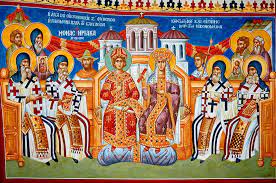Commemoration of the Seventh Ecumenical Council
Celebration date: 17/10/2021
Holiday type: Special calculation. It is celebrated on the Sunday between October 11 and 17 each year.
On the Sunday after the eleventh of October, we commemorate the Holy Fathers of the holy and Ecumenical Seventh Synod.
The Seventh Ecumenical Council convened in Nicaea, Bithynia from September 24 to October 13, 787 AD, at the initiative of Empress Irene, who acted as regent. Under the presidency of the Patriarch of Constantinople, Agios Tarasios (see February 25), three hundred and fifty Orthodox bishops gathered, and to them were added another seventeen hierarchs, who renounced the heresy of the iconoclasts.
Alongside the representatives of the Pope of Rome and the Patriarchs of Antioch and Jerusalem, the monks who suffered severe persecution during the reign of the iconoclastic emperors Leo III Isauros (717 – 741 AD) and Constantine V Copronimos (741 – 775 AD) .) were a strong presence; they numbered about one hundred and thirty-six.
After diligent preparation, the Fathers of the Synod anathematized the heretics, who for more than fifty years had forbidden the Orthodox Christians to honor the sacred images of Christ and His saints because this allegedly constituted idolatry. They thus put an end to the first period of iconoclasm, which, however, broke out again a few years later under Leo V Armenius (813 – 820 AD) and did not finally stop until 843 AD, thanks to the empress Theodora and patriarch Saint Methodius (see June 14).
the holy Fathers excommunicated the heretical patriarchs Anastasios, Constantine and Nikitas, repudiated the so-called ecumenical council convened in the palace of the Priesthood at the initiative of Constantine V in 754 AD, and proclaimed the eternal memory of the holy champions of Orthodoxy: the patriarch Saint Germanos (715 – 730 AD) [see May 12], Saint John of Damascus (see December 4), George of Cyprus, and all those who had suffered persecution and exile as defenders of holy icons. In the Pledge of Faith they read at the seventh and last session of the Synod, the Fathers declared:
“We define with precision every detail, next to the type of the honorable and life-giving cross, the septa and holy icon, those made of colors and mosaics and other materials deliberately placed, in the holy churches of God, in holy vessels and vestments, walls and sanisin, houses and streets; of the image of our Lord and God and Savior Jesus Christ, and of our Immaculate Lady the Holy Theotokos, honorable angels, and all holy and righteous men.
Inasmuch as they are constantly seen through virtual reprinting, so also these gods are directed towards the memory and desire of the originals, and they bowed down to the same embrace and honorific award, not the true worship according to our faith, which alone belongs to the divine nature – but the manner of the printing of the honorable and life-giving cross and the holy gospels and the other holy vows, and the offering of incense and lights in their honor, as well as the ancients are reverently used. “because the image’s value is transferred to the original”, and he who worships the image, worships in it the inscribed substance. Thus, the teaching of our holy Fathers is preserved, be it the traditions of the Catholic Church, which has received the gospel from end to end”.
The Holy Fathers therefore proved to be defenders not only of holy icons but, in essence, of the very mystery of the Incarnation of the Son of God: people of fellowship I picture God’s vision. I bow down to matter, and I bow down to the creator of matter, matter through me being born and dwelling in matter, condemned and through matter my salvation is worked out, and I do not stop respecting matter, through which my salvation works”.
Taking on human nature, the Word of God deified it without losing its idioms. For this reason, while in His glory it is incomprehensible to our senses, the human nature of the Savior can nevertheless be captured. the image of Christ – the faithfulness of which the tradition of the Church guards – consequently becomes the true presence of its divine-human model, a conduit of grace and sanctification to those who with faith give it honorable worship.
The Second Council of Nicaea is the seventh and last Ecumenical Council recognized by the Orthodox Church. However, this does not mean that other ecumenical Councils cannot be convened in the future, but that as the seventh Council of Nicaea completes the number that in the Holy Bible represents perfection and completion (eg, Gen. 2, 1-3) . It marks the end of the period of doctrinal conflicts, which allowed the Church to clarify with clear and precise definitions the limits of the Orthodox faith. Henceforth, every heresy can and will be able to be reduced to one of the errors that the Church anathematized in the ecumenical councils, from the first (325 AD) to the seventh (787 AD) in Nicaea Synod.


